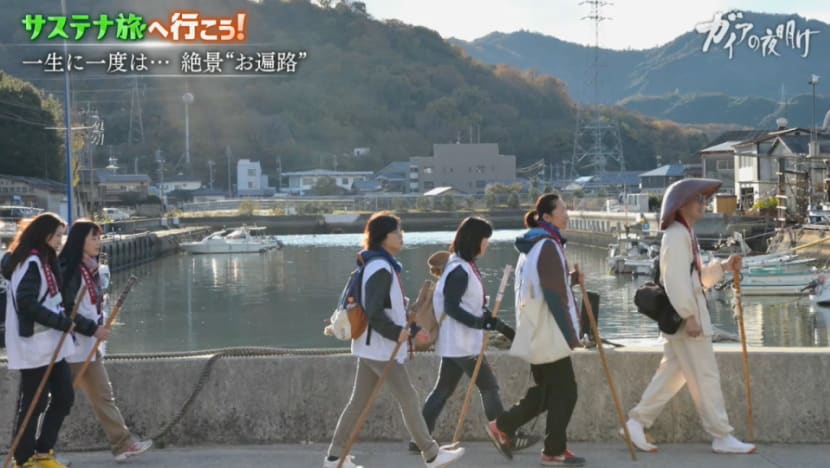Gaia Series 81: Let's Go On A Sustainer Trip!
Known for its hand-stretched somen noodles, Shodoshima faces challenges as most tourists only visit for a day. This episode explores efforts to encourage longer stays, including a pilgrimage tour and local initiatives supporting sustainable tourism.


This audio is generated by an AI tool.
This episode explores Shodoshima island’s efforts to transform tourism through sustainability, cultural preservation, and innovative visitor experiences.
Nestled in the Seto Inland Sea, Shodoshima is an island known for its scenic beauty and rich cultural heritage. With its warm climate fostering the cultivation of olives and the centuries-old tradition of hand-stretched somen noodles, the island has become a popular tourist destination. However, despite welcoming over 900,000 visitors annually, more than 70 per cent of them are day-trippers. This poses a significant challenge for the local economy, particularly for businesses such as inns and restaurants that rely on overnight stays.
Shingo Shiode, from the Shodoshima Tourism Association, is determined to change this trend by promoting sustainable tourism. “Shodoshima is often praised for having great potential,” he says. “But in reality, its full potential remains untapped.” One of the island’s hidden gems is the Nakayama Senmaida, a breathtaking collection of terraced rice fields built into the mountains. With a history of about 700 years, it is one of Japan’s 100 selected terraced rice fields. However, maintaining these terraces has become increasingly difficult due to a lack of manpower and funds, coupled with damage caused by wild boars.
To address this, the local community revived an annual tradition called Mushiokuri, in which people carry torches through the rice terraces to pray for a good harvest. They also started selling torches to tourists, with all 150 torches sold out last year. The proceeds help preserve the terraces and continue the tradition. “To protect these rice terraces, many people are making great efforts, and this resonates with visitors,” says a local farmer.
Sustainable tourism requires economic viability, and Shiode is exploring innovative ways to encourage longer stays. One promising initiative is the Shodoshima Pilgrimage Tour, which follows in the footsteps of the revered Buddhist monk Kukai. Unlike the famous Shikoku pilgrimage, which spans 1,400 kilometres and takes over six weeks to complete, the Shodoshima pilgrimage covers 150 kilometres and can be completed in 10 days. It once attracted 100,000 visitors annually, but now only about 1,000 make the journey.
Hoping to revive interest, Shiode collaborated with Jokoji Temple’s deputy head priest, Jiku Oobayashi. “For years, I had been contemplating the idea of launching a pilgrimage tour,” says Oobayashi. “A pilgrimage tour for inbound tourists—this time, for real.” As part of a trial, foreign tourists were invited to experience the tour, starting with a visit to a local sake brewery. There, they sampled award-winning sake made from rice grown in Nakayama Senmaida and enjoyed a meal featuring kasujiru, a miso soup made with sake lees.
The pilgrimage itself began on Goishi Mountain, home to one of Shodoshima’s 88 sacred sites. The journey led to the Namikiri Fudo Myo-o, a deity enshrined in a natural cave. Standing on the cliffside with no barriers, visitors can marvel at the breathtaking view of the Seto Inland Sea. “Sailors can see him from the sea, and they feel protected,” Oobayashi explains.
One of the highlights is the Goma fire ritual, a rare opportunity made possible through Oobayashi’s cooperation. Tour participants can write their wishes on wooden prayer sticks before offering them into the sacred flames. “Culturally, we don’t have anything like this at all in the UK,” says a British visitor. “That makes it feel fresh and unique.” An American tourist adds, “I really like it. And of course, the view is spectacular.”
The Shodoshima Pilgrimage Tour aligns with the principles of sustainable tourism, ensuring visitors contribute financially while preserving cultural traditions. This commitment was recognised when Shodoshima received the prestigious Green Destinations Award in October 2024, making it one of only 61 regions worldwide to earn this honour.
Meanwhile, another region facing tourism-related challenges is Hakuba in Nagano Prefecture. With record-breaking numbers of inbound tourists, the ski resort town is experiencing a surge in property prices, attracting international hotel chains. However, local inns, many family-run for generations, are struggling due to labour shortages and ageing populations.
Yutaka Wada, a former bureaucrat turned entrepreneur, is working to revitalise traditional accommodations. He took over Marukin Ryokan, a historic inn, and transformed its 80-person dining hall into a standalone restaurant called Yamabuki Shokudo. Partnering with a miso producer, the restaurant specialises in dishes like chanchan-yaki, a grilled fish dish with a miso-based sauce. The decision to stop meal service at the inn was difficult, especially for Asami Maruyama, who had been in charge of the kitchen. “We had up to 180 guests sometimes. In winter, it really felt like a battlefield,” she recalls.
The restaurant not only provides a dining option for tourists but also employs foreign staff to address labour shortages. “There’s a shortage of workers. Realistically, the easiest group to gather are foreigners,” says Wada. Since its opening, Yamabuki Shokudo has seen strong demand, offering hope for the sustainability of traditional inns as they focus on accommodation rather than the manpower-intensive task of providing meals.
Both Shodoshima and Hakuba illustrate the evolving landscape of Japanese tourism, where sustainability is no longer just an environmental concern but an economic necessity. “Doing things the same way as before won’t cut it,” says Wada. “The only sustainable solution is to keep doing new things.”
With initiatives like the Shodoshima Pilgrimage Tour and innovative business models in Hakuba, Japan is paving the way for a more sustainable future in tourism, ensuring that both visitors and local communities can thrive together.












